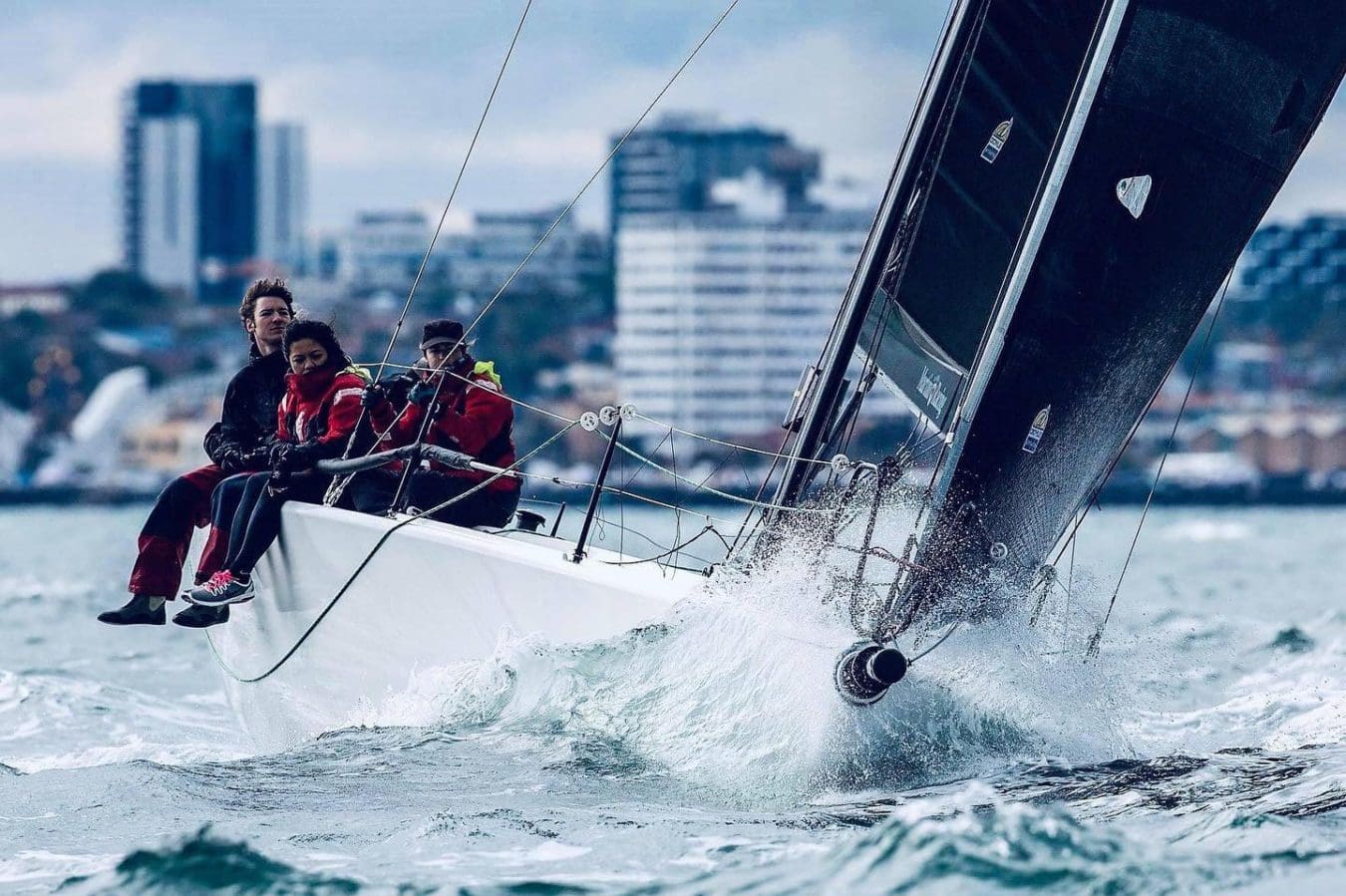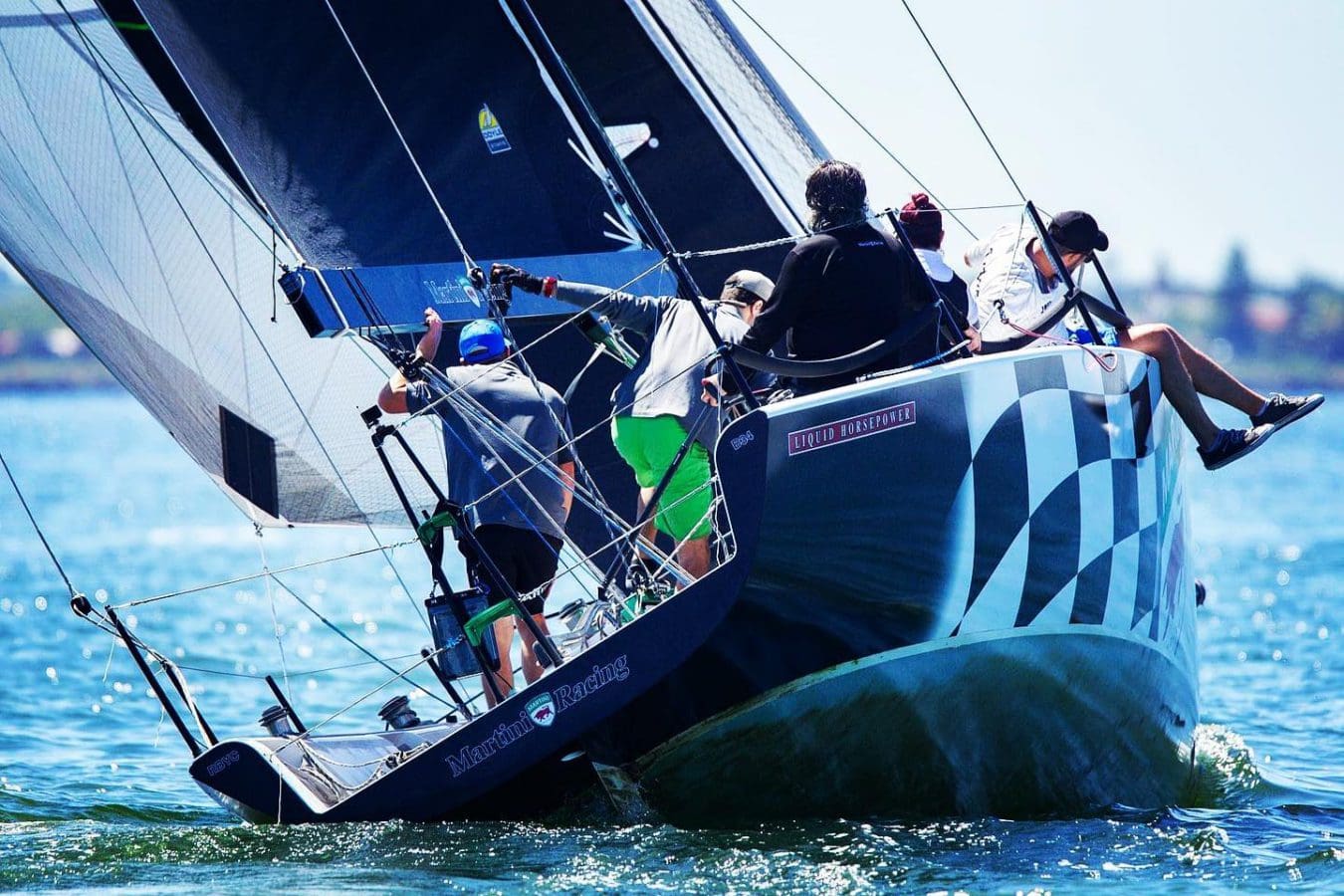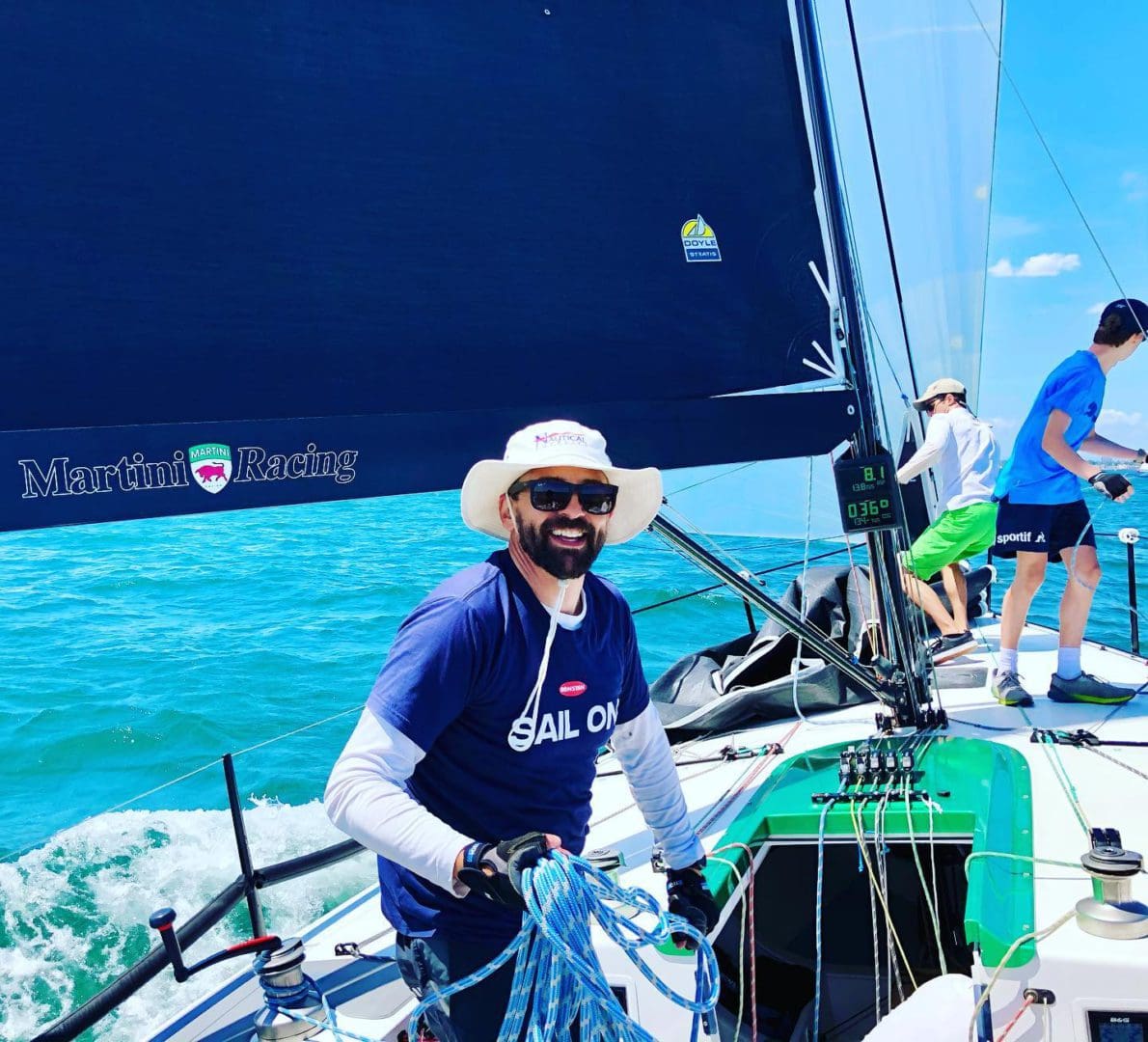Original article courtesy of Ronstan Australia
Over the past 20+ years, Tony Cuschieri of Martini Racing has built, or heavily modified a total of 11 sports boats at his factory in Rowville, not far from Ronstan’s Australian head office.
Tony’s first boat was an S&S designed Defiance 30, followed by a Beneteau 40.7 he imported from the US. Eventually, the sports boats of the era caught his eye, so in the late 90’s he built a Thompson 650 named Stormy.
As someone that “loves to build things”, Tony built six Thompson 870’s in the early 2000s. The most well-known was Gypsy, remembered for the infamous image of her powering downwind as Skandia Charlie Fish during the 2004 Skandia Geelong Week when it was chartered by the event sponsor.
After a break from sailing to focus on other areas of his business, Tony returned to sailing with Jayhawk, a J35, which was campaigned successfully for several years. Tony elected to return to sports boats in 2014 when he had the opportunity to purchase the moulds for the larger Thompson 980, which he felt would be a good fit for the growing Super 11 class. In the past, these moulds had produced two successful yachts, one of which made headlines as Navman Gladiator when first launched in 2002.

Tony’s plan “to perfect the T870 I started 15 years before” was to use a combination of the proven Thompson hull shape and modern design optimizations to produce the AC33, a competitive package capable of being sailed two-handed. With assistance from New Zealand based designer Kevin Dibley, the cabin of the T980 was replaced with a flush deck and the original furniture mouldings were replaced with a completely new internal structure. The rig was simplified “to get rid of some rag” and running backstays were eliminated thanks to a 37-degree spreader angle. The keel and bulb were re-designed by Naval Architect Hugh Welbourn, who has recently had a lot of success with his revolutionary DSS system. The rudder was designed by Tasmanian Naval Architect Fred Barrett, well known for boats such as Weapon of Choice and Young Guns. The carbon fibre mast was designed by highly experienced NZ Engineering firm Applied Engineering Services and manufactured by Pete Kula of Applied Composite Technologies in Melbourne. These elements were complemented by a sail package developed in conjunction with Col and Blake Anderson of Doyle Sails Melbourne. Deck Hardware was primarily all by Ronstan, with extensive use of Orbit Lashing Cars out of the Ronstan Denmark factory complimented by Robline Rope.
When launched at the end of January 2016 the AC33 came in around 400kg lighter than the original T980 and proved to be a great, easy to handle boat out on Port Phillip Bay, taking out numerous victories over the past 5 years.
After finding that he was doing minimal shorthanded racing and that he had a great crew keen to race regularly, Tony elected to try and improve on the AC33 by building a new, more lively boat in utilizing the talents of experienced local boatbuilder Matt Kelly.

In conjunction with Kevin Dibley and Peter Lawson from Hauraki Gulf Design (assisting with getting the boat to Category 2) the design was further optimized by extending the stern of the T980 mould by around 300mm, primarily to move the rudder back further to create more space in the cockpit. Increasing the separation of the rudder and keel improved steerage downwind in a big breeze. Interestingly this put the rudder back in the same position as the transom hung rudder on the original T980. Other changes included moving the keel back 50mm and the mast step aft by 300mm. Whilst the mast is only one meter taller than on the AC33 (increasing the mainsail area around 12.8%), the boom is slightly shorter, greatly increasing the aspect ratio, with running backstays added for improved control. Tony and Matt were conscious not to add any additional weight so the keel depth was increased 300mm to increase righting moment whilst maintaining a similar displacement.
The AC34 had a further optimized Ronstan deck hardware package, including a modern transverse headsail sheeting system using M022-2806 Series 22 custom cars. Ropeglide products were used extensively throughout the boat including RF8091-12 Fairleads and a significant number of Low Friction Rings. Deck hardware is all Ronstan products carefully selected for the task at hand, including Series 60 Orbit Blocks such as RF69109A. For this build, Tony elected to go with Andersen Winches (Andersen has been owned by Ronstan since 2010). In terms of sizing, the halyard and runner winches are 40ST’s and the primary winches are 46STs, providing plenty of grunt for trimming both the headsails and kites. Furthermore, the winches for the AC34 are finished in a custom “ZT Finish”, which is achieved by hand polishing the surface and then blasting the metal with a finishing media to give a matt finish. This is often described as the “gunmetal grey” or “titanium” finish. Tony considers them “far superior and easy to service” compared to other winches he has used in the past. When combined with the striking white, green, and black Martini graphics package the boat is a real head-turner in the marina! Again, the running rigging is primarily Admiral 5000 from Robline. This is required due to the low stretch in the high-end Doyle Stratis working sails. Traditional Polyester or lower grade Dyneema/Spectra halyards would stretch when heading upwind, whereas the SK78 core of the Admiral 5000 is able to cope with these loads to provide a satisfactory solution that keeps the crew on the rail and away from the halyard winches!

Whilst COVID has somewhat got in the way of sailing the AC34 since her launch in late 2019, initial signs have been promising with the top speed of 18.3 knots recorded in 22 knots of breeze whilst flying an A4 Kite.
In addition to the AC33 & AC34 programs mentioned above, Tony has always had a goal to compete in the big Queensland regattas such as Airlie Beach Race Week using a smaller, more easily transportable boat. Whilst this was goal was recently achieved aboard an immaculate Thompson 7, Tony and Matt were keen to push the limits with their most ambitious project yet.
With a goal of achieving a similar righting moment to a Thompson 8 but with a goal of only sailing with four crew, water ballast was considered, however, the engineering required and the additional displacement with water onboard soon ruled this out. DSS-style lifting foils were considered however it was found that the hull shape wasn’t suitable for this, so a canting, lifting keel was determined to be the ideal solution. In addition, Matt’s experience building The Brothers (a radical canting keeler raced out of Port Fairy in Victoria) made this quite a straightforward project. The canting mechanism is operated by the two Andersen 28ST primary winches onboard, the theory being that the windward winch will always be free to grind the corresponding canting keel line (which come from the leeward side of the boat via Ronstan’s new Soft Attachment Blocks, which keep the friction in the system low thanks to the composite journal bearings and duplex stainless steel hubs). The cockpit floor was lowered almost 200mm to improve comfort in the cockpit.
A single retractable canard was added just forward of the keel, which keeps leeway under control when the keel is 37 degrees out to windward. Videos of the canting keel in action appear to give the impression that the righting moment gain is comparable to bringing 2 large crew up onto the windward rail, with a significant amount of mainsheet suddenly required.
The boats unique underwater package is made even more interesting by the rudder design. The original transom hung rudder of the Young 780 has been replaced by a smaller rudder mounted in a removable cassette in the transom. The rudder is made even more radical by the presence of tubercles on the leading edge. Whilst whales have been exploiting this phenomenon for thousands of years, it is rarely seen in the yachting world up until recently. A quick Google search reveals that tests in other industries have found that the presence of tubercles can increase lift by 4.8% and decrease the effects of drag by up to 40%, whilst simultaneously changing the stall characteristics of the foil. Tony and Matt were keen to give it a go as they felt it would improve handling at low speed to prevent stalls in prestart manoeuvres and other down speed situations.
The new dual spreader Applied Composites mast is stiffer and lighter than the original 3-spreader Rocket 780 spar. Again, sails from Doyle Melbourne have been used.
The hull also has an interesting transom extension Kelly came up with the crew called the “diffuser”. This interesting extension causes water to be deflected downwards to generate some lift on the transom, helping to keep the bow down, as the T foil rudder on an i14. It also helps to unstick the wide, flat transom in marginal planning conditions.
The large square top Doyle mainsail is kept under control by a Series 26 ball-bearing Orbit Traveller system just forward of the helm, allowing Tony to trim the main during two-handed events. One of my personal favourites, the RF35109HL 30mm block has been used extensively at the mast base as well as in the vang system to keep friction and weight low without sacrificing strength. The new RF70 ball bearing swivel cleat has also been used on the vang to allow easy adjustment by the crew on the rail.
Thanks to Tony Cuschieri for both his continued support of Ronstan and his assistance with this article. Further thanks to Matt Kelly for his assistance with this article.
ABOUT DOYLE MELBOURNE // Col Anderson has been continuously involved in the sailmaking industry for over 48 years, since starting his apprenticeship with Prior sails. An Australian Championship win in the International Cadet Class in 1964 was followed in 1979 by winning the Australian Quarter Ton Title. Col developed a passion for offshore sailing after sailing in the 1973 Sydney Hobart race on Banjo Paterson, and as sailmaker and trimmer on Police Car in the winning Australian team for the 1979 Admirals Cup, Col also sailed in the horrific Fastnet Race that year. After being introduced to sailing great Lou Abrahams, and becoming his sailmaker, a long term association started, which led to 15 Sydney Hobart’s (2 wins and a second), 2 Admirals Cups and 6 Kenwood Cups. Col sailed another 17 Sydney Hobart’s with several other owners including Syd Fischer and Howard de Torres, adding another second and third overall.
When not offshore sailing, Col has continued to race competitively on Port Phillip Bay in various classes, including Yachting World Diamonds, Classic yachts, Couta Boats and he is currently sailing on the Beneteau 45 Reverie in IRC Division 1 of the Club Marine series.
